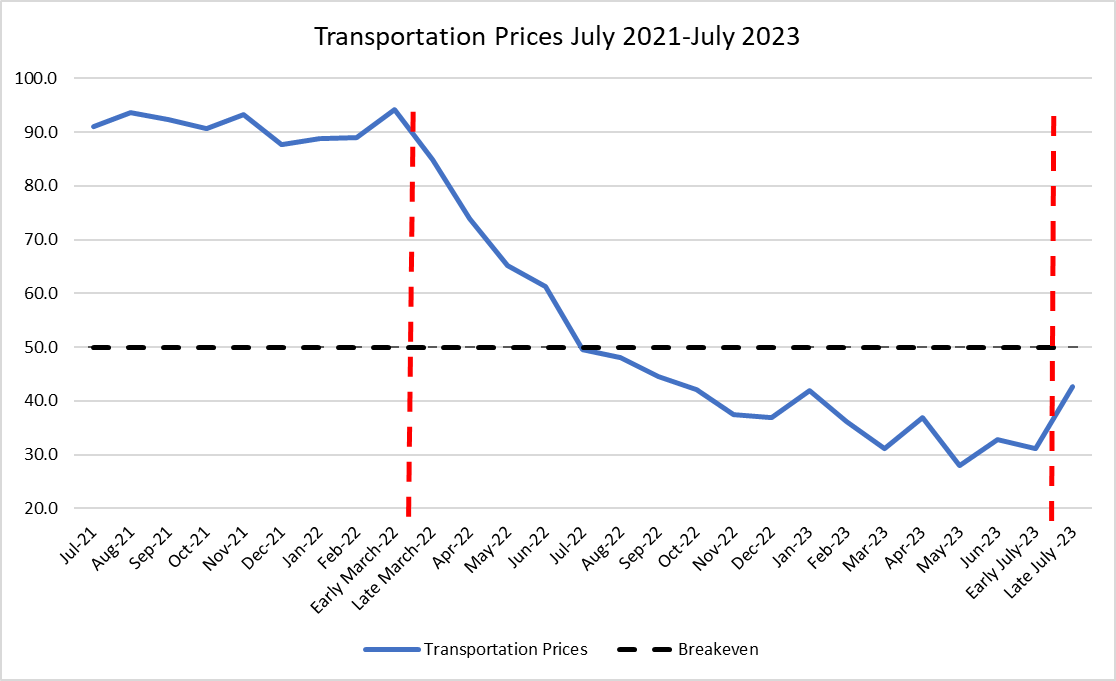Logistics economy slowed in July
Economic activity across the logistics industry contracted for the third straight month, according to latest Logistics Managers’ Index.

Economic conditions in the logistics industry slowed in July, continuing a downward trend that began earlier this year, according to the latest Logistics Managers’ Index report (LMI), released this week. Warehousing metrics continued to boost the overall index, but are beginning to soften, and sluggish conditions remained across transportation.
The LMI reached an all-time low reading of 45.4, down slightly compared to June and marking the third straight month the index has contracted. The report is based on a monthly survey of logistics managers nationwide; a reading above 50 indicates expansion and a reading below 50 indicates contraction in the market.
Industry growth began to slow in 2022 following record-high demand for logistics services during the pandemic, but 2023 marks the first time the LMI has hit negative territory, indicating low demand for services. The index started the year at 57.6 in January, indicating moderate growth levels, but has declined every month since, dipping below 50 in May.
LMI researcher Zac Rogers, associate professor of supply chain management at Colorado State University, pointed to shifting conditions in warehousing and transportation as key changes in July. Inventory levels saw their steepest rate of contraction during the month, leading to slowing rates of growth for both warehousing utilization and warehousing prices, and causing warehousing capacity to expand for a fourth straight month. This bucks the typical summer trend of increasing inventory levels in preparation for peak season, which Rogers says is due to two factors.
“First, [companies] may believe that there is a lot of flexibility in freight markets right now, and that rush orders will be possible. Many retailers have talked about wanting to move back toward [just-in-time] inventory management, [and] the continued drop in inventories might be proof of this,” Rogers wrote in the July report. “Second, after being burned by overstocks in 2022, firms may be hesitant to ramp back up. This could be particularly true for firms who are still locked into higher storage costs.”
The changes in warehousing coincide with some signs of life in transportation. Although the freight recession continues, Rogers said the LMI’s transportation metrics started to improve during the month and may signal that the sector is nearing the bottom of its downturn. Transportation capacity expanded in July, but at a slower rate compared to June, for example. Rogers said the changes were especially notable at the end of July with the news that Yellow Corp., the nation’s third largest less-than-truckload (LTL) carrier, was shutting down. LMI researchers have speculated in past reports that the freight recession will eventually end when capacity exits the market.

“The hope is that demand will come up as well,” Rogers said in a separate interview about the July report. “The freight market … is still in a recession, but we think we can see where it may end. July of 2023 might be when we start to turn the corner.”
The LMI is a monthly survey of logistics managers from across the country. It tracks industry growth overall and across eight areas: inventory levels and costs; warehousing capacity, utilization, and prices; and transportation capacity, utilization, and prices. The report is released monthly by researchers from Arizona State University, Colorado State University, Rochester Institute of Technology, Rutgers University, and the University of Nevada, Reno, in conjunction with the Council of Supply Chain Management Professionals (CSCMP).
Related Articles

Copyright ©2024. All Rights ReservedDesign, CMS, Hosting & Web Development :: ePublishing